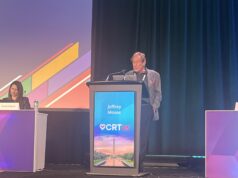
A secondary analysis of repeat revascularisation in the EXCEL trial has found that it was associated with increased mortality after both percutaneous coronary intervention (PCI) and coronary artery bypass graft (CABG) in patients with left main coronary artery disease (LMCAD). The EXCEL investigators also noted that, consistent with previous studies, repeat revascularisation was performed less frequently following CABG than PCI, and suggest this may have contributed to the higher rate of all-cause mortality seen with PCI in EXCEL. The findings of the main EXCEL trial have been the subject of much recent debate, including the incidence of myocardial infarction, which was not measured according to the universal definition.
The authors of the current analysis concluded that reducing the need for repeat revascularisation may further improve long-term survival after percutaneous or surgical treatment of left main disease. Writing in JACC: Cardiovascular Interventions, Gennaro Giustino (Icahn School of Medicine at Mount Sinai, New York, USA) et al say: “Our findings in an unprotected LMCAD population suggest that the need for, and performance of, repeat revascularisation procedures have prognostic implications, the magnitude of which depends on its indication and type of repeat revascularisation procedure.”
EXCEL was an international, open-label, multicentre, randomised trial that compared PCI using everolimus-eluting stents (Xience, Abbott) versus CABG in patients with LMCAD. The present study is a secondary analysis from the EXCEL trial investigating the incidence, risk factors, and prognostic impact of the performance of repeat revascularisation procedures following PCI and CABG. All analyses were performed in the intention-to-treat population, and included all patients in the EXCEL trial with LMCAD and site-assessed low or intermediate SYNTAX score randomised to PCI (n=948) or CABG (n=957). Repeat revascularisation events were adjudicated by an independent clinical event committee. The association of repeat revascularisation with the risk of mortality at three years was evaluated with multivariable Cox regression models
During three-year follow-up, there were 346 repeat revascularisation procedures among 185 patients. PCI was associated with higher rates of any repeat revascularisation (12.9% vs.7.6%, hazard ratio [HR] 1.73, 95% confidence interval [CI] 1.28–2.33, p=0.0003). Need for repeat revascularisation was independently associated with increased risk of three-year all-cause mortality (adjusted HR [adjHR] 2.05, 95% CI 1.13–3.7, p=0.02) and cardiovascular mortality (adjHR 4.22, 95% CI 2.10–8.48, p<0.0001) consistently after both PCI and CABG (pint=0.85 for both endpoints). Although target vessel revascularisation (TVR) and target lesion revascularisation (TLR) were both associated with an increased risk of mortality, target-vessel non-TLR and non-TVR were not.
Giustino et al found that the repeat revascularisation procedures were mostly beyond the first six months after the index procedure. A repeat revascularisation procedure was an independent predictor of a subsequent increase in all-cause and cardiovascular mortality within three years after both PCI and CABG, a risk, they found, that peaked within 30 days after the repeat procedure and then declined over time. This, they say, suggests that “the actual event of repeat revascularisation per se was associated with increased risk”. The authors propose that a multifactorial association between repeat revascularisation and mortality is likely, and that it may be “both causative and associative in nature”.
Among the contributing factors they point to are that prolonged dual antiplatelet therapy after repeat revascularisation is associated with increased bleeding and, in some reports, mortality, and that it exposes patients to new hospitalisations, with integral risks, including the risks of the procedure itself. “In this regard, mortality was significantly greater after repeat revascularisation by CABG but not after PCI, reflecting inherent differences in the risks of these two strategies. This observation suggests that CABG should be reserved for repeat revascularisation procedures that are not amenable to repeat PCI, irrespective of the initial revascularisation approach.”
Giustino and colleagues write: “Repeat revascularisation procedures are performed for less severe anginal symptoms and health status deterioration after PCI compared with CABG”, which, the authors speculate, may reflect differences in the threshold for, or anatomic suitability of, further revascularisation after each procedure. They add: “This differential threshold may in part explain the more frequent use of repeat revascularisation after PCI compared with CABG.”
The EXCEL researchers also found that repeat revascularisation was not associated with increased risk of non-cardiac mortality. However, they caution that, as the study was a secondary analysis from a randomised controlled trial, the findings should be considered hypothesis generating.
They conclude: “Measures to reduce the need for repeat revascularisation including improved stent platforms and implantation technique, use of pan-arterial bypass grafting and aggressive risk factor control with guideline-directed medical therapy may improve prognosis after both PCI and CABG.”
In an accompanying editorial comment, David O Williams (Brigham and Women’s Hospital, Boston, USA) agrees with the EXCEL investigators that “enhancing the durability of the initial revascularisation procedure is an important goal”.
He says: “In EXCEL, more than half of those with a repeat revascularisation had another one subsequently. This finding supports the concept that there are patient specific factors that are associated with refractoriness to coronary interventions or a tendency to more rapid disease progression. A more basic understanding of the biology of lesion recurrence may assist in improving the durability of PCI in these circumstances.”










